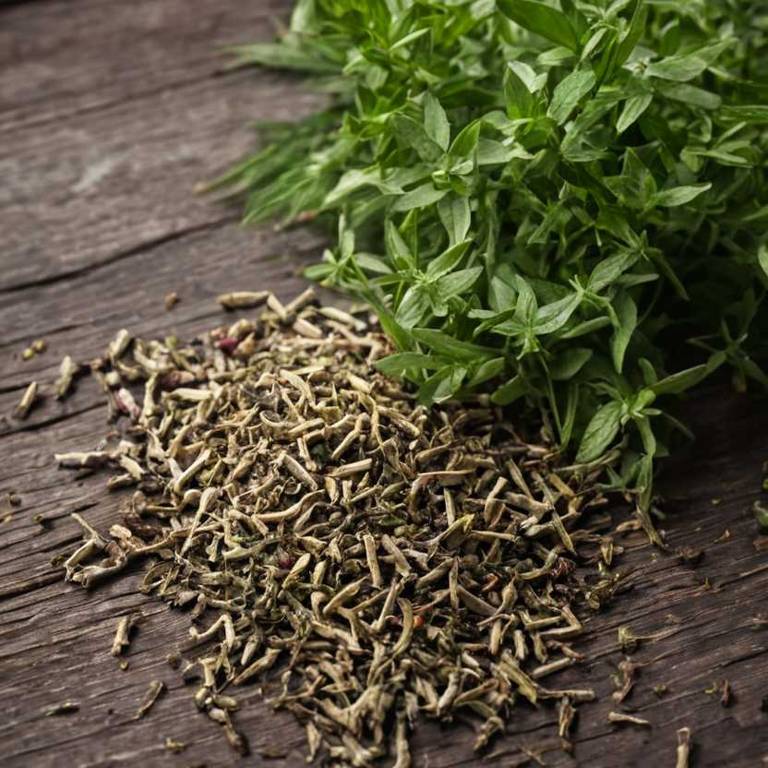By Leen Randell
Updated: Jul 20, 2024
10 Medicinal Constituents Of Polygonum Aviculare (Knotweed)

Polygonum aviculare has active constituents such as polyphenols, flavonoids, and triterpenoids.
These medicinal properties give knotweed anti-inflammatory, antioxidant, and antimicrobial effects. The constituents can help alleviate conditions such as eczema, acne, and rosacea, while also reducing the risk of cardiovascular disease and improving wound healing.
For example, studies have shown that polyphenols in knotweed can help reduce inflammation and improve symptoms in patients with chronic eczema, thereby improving the quality of life.
This article explains in details the 10 best active constituents of Polygonum aviculare.
1. Gallic acid
Polygonum aviculare gallic acid is a type of phenolic compound found in its leaves and stems.
This potent antioxidant has been traditionally used in traditional medicine to treat various ailments, including inflammation, diarrhea, and fever.
Gallic acid has also been studied for its potential anti-cancer and antimicrobial properties, making it a promising area of research in the fields of pharmacology and nutrition.
2. Flavonoids
Polygonum aviculare flavonoids is a group of plant-derived compounds found in its aerial parts.
These flavonoids have been extensively studied for their pharmacological activities, including antioxidant, anti-inflammatory, and antimicrobial properties.
They have also been shown to exhibit cytotoxic effects on certain cancer cell lines, making them a promising area of research for the development of new therapeutic agents.
3. Phenolic acids
Polygonum aviculare phenolic acids is a class of compounds that have been identified in its leaves and stems.
These phenolics are responsible for the plant's antioxidant, anti-inflammatory, and antimicrobial properties. They have been shown to exhibit significant bioactive effects, including scavenging free radicals, inhibiting lipid peroxidation, and exhibiting antibacterial activities.
The composition of phenolic acids in P. aviculare varies depending on factors such as growth conditions and part of the plant used.
4. Anthocyanins
Polygonum aviculare anthocyanins is a type of flavonoid pigment responsible for its red, purple, and blue colors.
These water-soluble compounds are highly reactive and have been found to possess various biological activities, including antioxidant, anti-inflammatory, and antimicrobial effects.
Anthocyanins from Polygonum aviculare have been studied for their potential health benefits, such as protecting against cardiovascular disease, cancer, and neurodegenerative disorders.
5. Quercetin
Polygonum aviculare quercetin is a bioflavonoid compound found in its aerial parts.
It has been traditionally used for medicinal purposes due to its anti-inflammatory and antioxidant properties. Quercetin has been shown to exhibit various biological activities including vasodilatory effects, platelet aggregation inhibition, and antimicrobial actions, making it a potential natural remedy for cardiovascular and inflammatory disorders.
Its potent antioxidant activity also contributes to its ability to protect against oxidative stress and cell damage.
6. Kaempferol
Polygonum aviculare kaempferol is a flavonoid compound found in high concentration in its leaves and stems.
It has been extensively studied for its various biological activities, including antioxidant, anti-inflammatory, and antimicrobial properties.
Kaempferol has also been shown to possess anticancer and cardioprotective effects, making it a potential therapeutic agent for the prevention and treatment of several diseases.
7. Ellagic acid
Polygonum aviculare ellagic acid is a polyphenolic compound extracted from its leaves.
It has been extensively studied for its potential health benefits, including anti-cancer and anti-inflammatory properties. Ellagic acid has been shown to inhibit the growth of cancer cells and induce apoptosis, making it a promising candidate in the prevention and treatment of various cancers.
Additionally, it has antioxidant and antimicrobial activities, suggesting its potential in protecting against diseases and promoting overall well-being.
8. Catechin
Polygonum aviculare catechin is a type of flavonoid antioxidant found in its leaves.
This powerful compound has been extensively studied for its potential health benefits, including anti-inflammatory and antimicrobial properties.
It has also been shown to have antioxidant activities, which can help protect cells from damage caused by free radicals.
9. Galactomannan
Polygonum aviculare galactomannan is a type of polysaccharide found in its rhizomes.
It has been shown to have potential antimicrobial and antiviral properties, making it a promising candidate for the development of new medicines.
Studies have demonstrated its ability to inhibit the growth of various microorganisms, including bacteria and viruses, highlighting its potential as a natural preservative and therapeutic agent.
10. Aldehydes
Polygonum aviculare aldehydes is a type of organic compound found in its leaves and stems.
These aldehydes are responsible for the plant's characteristic pungent and sweet fragrance, often used in traditional medicine to treat various ailments. The aldehydes have been shown to exhibit antioxidant and anti-inflammatory properties, making them a valuable component in natural remedies.
Further research is needed to fully understand their potential benefits and uses.